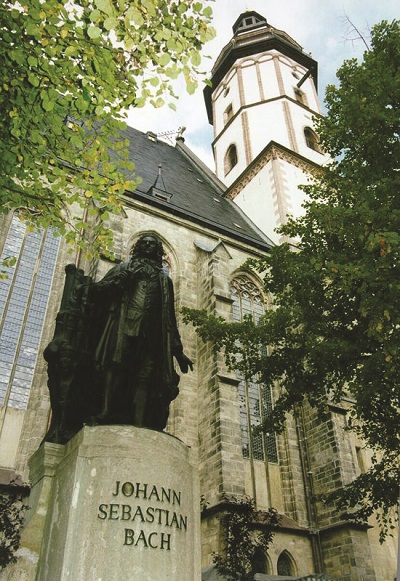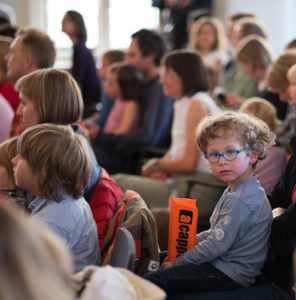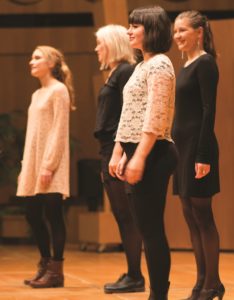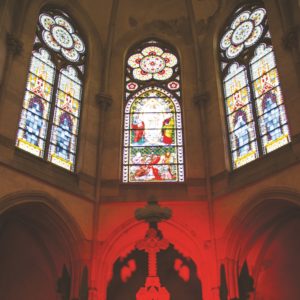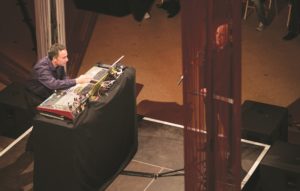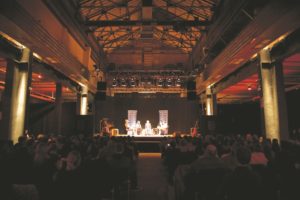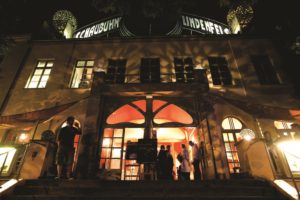Amacord Hosts Ensembles From Around the World
Graham Lack, composer and ICB Consultant Editor
The well-wooded hills of the River Saale impinge on its course, as this tributary of the Elbe meanders past Hof and the university town of Jena before being deflected towards Naumburg, from here on this historic watercourse navigable by barge to Halle. Barley and sugar beets would have been transported this way until the middle of the 20th century. Some smaller towns in the State of Thuringia may be glimpsed, their names more readily readable on the façades of dilapidated factory buildings set back some distance from the track than on the station signboards themselves: Probstzella, Oberloquitz – inevitably with Unterloquitz just down the line – and the indefatigably-named Crölpa-Löbschütz, evidence perhaps of toponyms whose early roots are both German and Czech. As we pass Saalfeld the former premises of a chocolate manufacturer come into view, the ‘Schokoladenfabrik Stollwerck-Sprengel’. The train, in case you wondered, is an ICE, a technologically advanced model worthy of Germany’s engineering heritage but, compared to the older corridor trains, somehow less gemütlich.
Our destination was Leipzig, where the 13th A Cappella Festival was being held from 20-29 April. The city has some famous venues: the Gewandhaus, whose most famous Kapellmeister was Felix Mendelssohn Bartholdy and which the Gewandhausorchester can still call its home, and the Thomaskirche for example, where Johann Sebastian Bach served as Kantor from 1723 until his death in 1750.
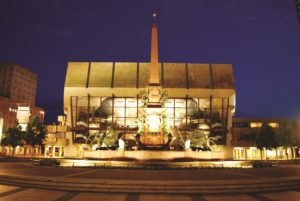
The present incumbent, appointed in 1992, is Georg Christoph Biller, only the 16th Thomaskantor in fact. And although the early evening Friday concert was not part of the festival programme proper, it seemed a good way in to a week of vocal music. The church was packed to the rafters, and I was one of the lucky few to be admitted just as the famous Thomanerchor, celebrating its 800th anniversary in 2012, processed towards the altar. As in many a sacred building with a long musical tradition, the acoustics are so good that even in the rear pews the complex polyphony of the double motet Der Geist hilft unser Schwachheit auf, which Bach wrote in October 1729 for the funeral of the Rektor of the Thomasschule, Johann Heinrich Ernesti, was eminently clear.
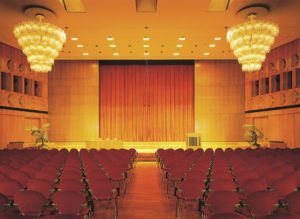
The opening concert of A Cappella Leipzig has become another tradition, if not such a long one, and is given by the city’s local matadors Amarcord, sometimes in the Peterskirche but usually in the Mendelssohn-Saal of the Gewandhaus. This ensemble won Second Prize in the category ‘Profane’ at the Tolosa Choral Contest, Spain, back in 1995 and, in 1999, at the Tampere Vocal Music Festival, was awarded a joint Third Prize along with the Finnish group Tsakku.
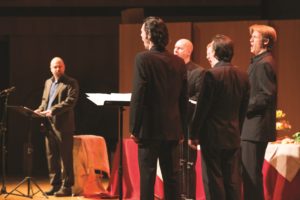
The programme was loosely based around works by Orlando di Lasso, the five singers from Amarcord having conducted, apparently, “a vigorous search in Lassus’s music cabinet”, raiding it for “rousing villanelles, elaborate madrigals and courtly chansons”. The in-jokes of the Renaissance were not so different to quips musicians make today, and singers out of their depth, or snide references to noses of all shapes and sizes, seem just as risible now.
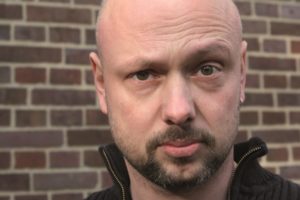
Andreas Rehschuh as Orlando di Lasso
The next evening belonged to VOCES8, the best of British as it were. The venue, on an industrial estate on the outskirts of Leipzig, was the Theater-Fabrik-Sachsen.

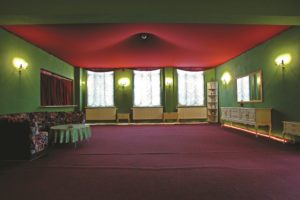

It is home to Saxony’s fringe theatre really, the company having taken over the paint and varnish works of Lacufa GmbH, a firm founded in 1886 and which survived the GDR era by producing coatings for the ubiquitous Trabant motorcars. Avid ‘Trabi’ collectors today still hunt down old stocks of dolphin grey paint. This was the ensemble’s first appearance at the festival and it was a pity that the technical team caused a slight kerfuffle, expecting them for some reason to sing ‘on mike’, not part of their performing ethos to date. I had bumped into Florian Städtler earlier in the day, the ‘roving reporter’ and ‘chief listener’ of Vocal Blog, which has gathered quite a fan base recently. He said just how excited he was to hear this “world-class classical vocal ensemble”, pointing up the fact that their increasingly enhanced international profile has been based on the concept of “acoustic a cappella music”. At the 2006 Tolosa Choral Contest, VOCES8 walked off with both First Prize ‘Sacred’ and First Prize ‘Profane’, having already taken First Prize and Audience Prize at the 44th International Competition of Choral Singing ‘C.A. Seghizzi’ held in Gorizia, Italy in 2005.
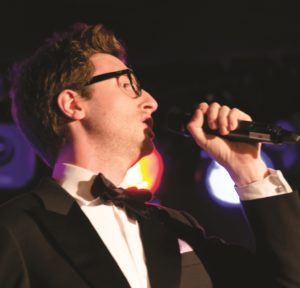
Their ‘Aces High’ programme features James Bond soundtrack themes and classic Gershwin and Bernstein tunes, and relies on a suave blend that can only be achieved without any amplification. For the Theaterfabrik Sachsen and the festival organisation it was a rite of initiation, and such hiccups will occur it seems. And if the theatre’s plush seating reminiscent of a 1950s cinema forced VOCES8 to make quite a number of last minute programmatic changes, then the singers still accomplished their mission with coolness and glamour – on her Majesty’s secret service, of course.
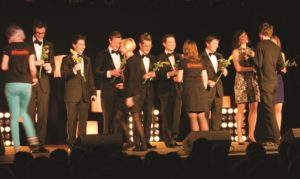
The Monday papers were full of plaudits for the weekend’s events: standing ovations and two encores at the end of the VOCES8 concert, praise for Amarcord and Andreas Rehschuh, the theatre director who had personified di Lasso and read aloud his letters. It was a pleasure to sift through the local press in that haven of peace, the Café Riquet. The premises currently host a Viennese coffee house, accommodated a porcelain shop before that, and were erected in 1908 by the Riquet trading company, which was founded in 1745 primarily for importing wares such as tea and cocoa from Africa, China, and the Far East. The building was one of the most modern in Leipzig at the time and remains a rare example of Jugendstil in the inner city.
The ensemble Heinavanker hails from Estonia: their name means ‘haywain’ in English and is derived from an altar painting by Hieronymus Bosch. The artist depicts a huge waggon-load of hay rolling through a world vexed by agony and greed on its way to destruction. But atop the bale of hay there sounds beautiful music. Does it reach the ghastly dream seething below? Their concerts incorporate elements of sacred iconic art and the musical liturgy, with early vocal polyphony lying at the heart of their performance. Heinavanker also draws on early Estonian folk tunes that depict the bright and the dark side of life. One of their trademark songs is among the oldest and most distinctive examples of Estonian culture: a pre-Christian runic song from the Kadrina region simply called Loomiselaul (The Creation). It is about a bird that makes a nesting place in a paddock, lays eggs and hatches offspring. One of the fledglings becomes the sun, the second the moon, the third a star, and the fourth a rainbow. The vocal tradition associated with such songs possibly dates back many thousands of years.
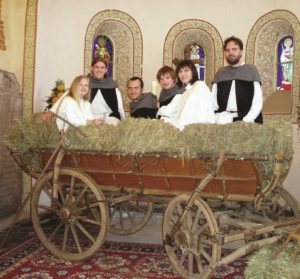
Since 1988, the ensemble has undertaken many concert tours: including Finland, France, Germany, Poland, Scandinavia and Switzerland, participated at the Moscow Early Music Festival and the Aarhus Festival, Denmark, were invited to perform at the EXPO 2000 in Hannover and have appeared at many major cultural and musical summer events in Germany including the MDR Musiksommer, Nordhessen Kultursommer, Schönberger Musiksommer, Internationale A Cappella Woche Hannover, Hohenloher Kultursommer, Uckermärkische Musikwochen, Heilbronner Kirchenmusiktage, Musiksommer Mecklenburg-Vorpommern, and Kloster Zinna Sommermusiken. After many performances in Europe, Heinavanker finally toured the United States in 2006. They have broadcast extensively for radio and television.
For their Leipzig appearance in the Thomaskirche, Heinavanker combined movements from mass settings by Johannes Ockeghem (1417-1497) with ancient runic singing. Their concerts explore the relationship between the solemn contrapuntal masterpieces of the Renaissance that reflect the courtly, religious and scientific spirit of the era, and the meditative, monophonic and monastic music of the Middle Ages. The Estonian population is very small, and it is astonishing to note how many sacred choral pieces emanated so early on, works exhibiting strong folk influences the vitality of which reflects perhaps an early religious awakening. The corner stone of the Leipzig programme ‘From Cloisters and Hovels’ remained Ockeghem, whose at times arcane music achieves an extraordinary balance between hidden mathematical constructions and apparently spontaneous melodic lines. His works make such unusual demands on the singers that their performance is considered a test of courage. Pitted against this were folksong settings such as Haned kadunud or Loomine, the latter choreographed to excellent effect.

Strolling around Leipzig next day I made a determined effort to avoid the many building sites and tourist hot spots like the ‘Zillstunnel’, where guests sit outside shoulder to shoulder in different establishments that have become just one long and rather indifferent restaurant. But as the Alte Handelsbörse came into view, I felt rewarded. Who needs Wall Street? The ‘Old Stock Exchange’ was completed in 1687 at the end of the Thirty Years War and is in the Early Baroque style; it was designed as a representative building where merchants from all over the world could meet. Today it hosts scientific lectures, company conferences and private receptions, but also many literary and musical events.
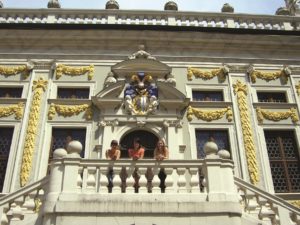
“Hurrah, they’re here again” exclaimed the festival programme, for LALÁ, one of the winners of the 2011 A Cappella Competition Leipzig, was making a reappearance at the festival, this time at the Alte Handelsbörse. These four “charming Austrians are even capable of winning over the youngsters with their love of singing”, the blurb continued. Family concerts have become de rigueur at many festivals, and what a good idea this is too. No sooner than they enter the stage, LALÁ leave on a whimsical flight of fancy, their moving tales transported on the wings of song and helping listeners young and old alike connect tangibly to the a cappella art.
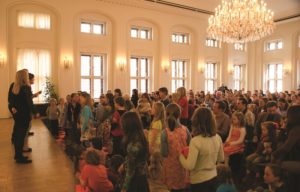
The hallmark of the Norwegian vocal group Nordic Voices must surely be a broad spectrum of musical forms of expression. Like many a cappella ensembles today, they seek to combine early and contemporary music in their programmes. The theme of their concert in Leipzig’s Evangelisch-reformierte Kirche was, simply, ‘Nature’. Several works chosen are heavily onomatopoeic, many a natural phenomenon captured in the purest beauty of vocal sound.
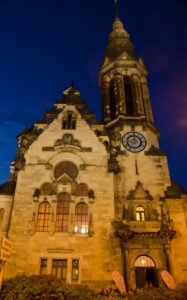
Johannes Ciconia (ca. 1370-1412) is a pivotal figure in early music history, and straddles the divide between Medieval and Renaissance music. He was born in Flanders before moving to Italy in the late 14th century, where he worked both in Rome and Padua. Characterized by lively rhythmic patterns in the discantus and a new, rich sonority that favours the use of thirds, his harmonic style is, in one sense, quite ‘modern’, and reflects the rise of Pythagorean intonation. Recent concerts by Nordic Voices feature a Ciconia motet about sunbeams, along with a new work on the same subject matter by Norwegian composer Lasse Thoresen. These are the musico-historical stepping stones within the programme itself.
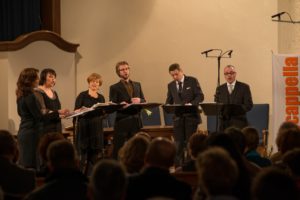
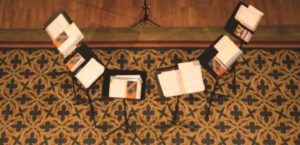
Kraja, allocated the Mendelssohn-Saal, is one of the more remarkable discoveries on the Swedish vocal music scene.
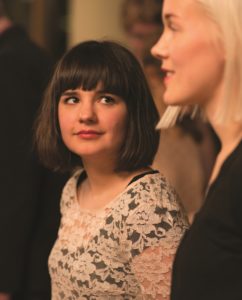
Four young singers become a single instrument that allows the unique sounds of Scandinavian folk music with its enchanting harmonic textures to resonate with intimacy. Kraja is Lisa Lestander, Linnea Nilsson, Frida Johansson and Eva Lestander, all from Umeå in the north of Sweden.
They formed back in spring of 2002, for a single gig – or so they thought – at the Umeå Folkmusicfestival. Their repertoire comprises Swedish traditional songs, love-songs, dance tunes, hymns and their own material too, but all in bespoke arrangements. Kraja has toured Germany, Finland, Norway, Denmark, the Ukraine, Russia, Austria and Estonia. In June 2008 they released the album ‘Under himmelens fäste’ and later that year ‘Skaren: Norrland III’ along with Jonas Knutsson and Johan Norberg. This admixture of traditional and newly composed songs imbues their programmes with an astounding naturalness.
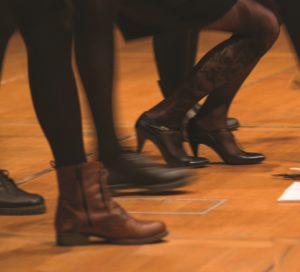
Back at the Theater-Fabrik-Sachsen, Cap Pela, from Majorca, were live in a concert that thrilled the audience. In addition to adaptations of popular songs from pop and film music they had brought along original Catalan settings too. Their vocal acrobatics are of the highest calibre and presented in a rousing stage show full of joy and abandon.
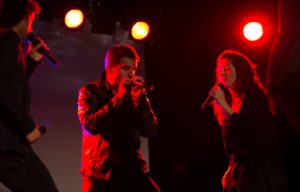
The Peterskirche in which sound artist Ambrose Field and former Hilliard Ensemble tenor John Potter took an electronic journey of discovery back to the Renaissance is not the one that was founded as an Augustinian chapel in 1213 in the former village of St Petri.
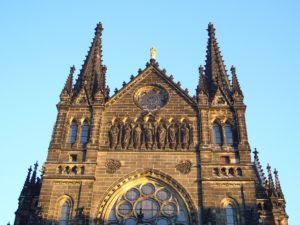
The original building was reconstructed as a ‘hall church’ in 1507, taken over by the town in 1539 and used for secular purposes, before being renovated in 1712 and opened for Lutheran services. It was replaced by a new Peterskirche on the ‘Schletterplatz’ in 1886 and subsequently torn down.
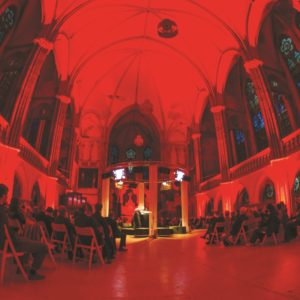
In the present neo-Gothic building Potter sang fragmentary vocal lines from works by Guillaume Dufay. Field multiplied and modified this digitally into new material. The outcome is a contemporary sound which somehow preserves the essence of 15th century Franco-Flemish vocal polyphony. A multimedia event, video sequences by Michael Lynch chosen to go with the collaboration lent the evening a meditative note.
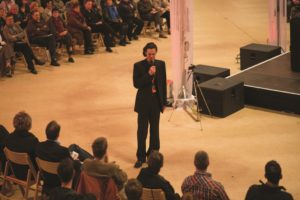
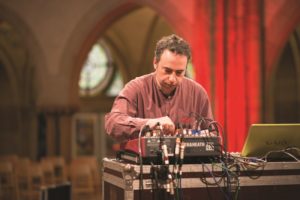
One looks in vain for a big tour bus where Audiofeels are singing, but they always manage to have percussion, electric guitar, double bass, trumpet and an entire string orchestra on board. Well, instruments produced by their voices alone. Each singer has quite remarkable abilities, allowing the group to breathe new life into successful rock and pop hits by Michael Jackson, the Bee Gees, Quincy Jones or the Red Hot Chili Peppers. These Polish newcomers stop at nothing and won over the jury and the audience at the A Cappella Competition last year in Leipzig. This year they rocked the Werk-2 venue. Apropos venue, Werk-2 was erected in 1848 to manufacture gasometers, was liquidated in 1952 and started producing mechanical materials testing machinery under the GDR regime, became an arts centre in 1992 after the reunification of Germany, before being acquired by the City of Leipzig in 1996 as a ‘Socio-Cultural Centre’. The buildings were entirely renovated by Augustin & Imkamp in 2004. A year later saw the introduction of the ‘Alternative Christmas Market’, which has enjoyed great popularity since.
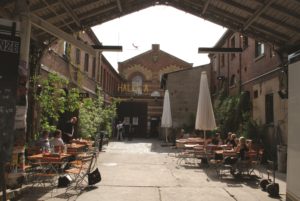
The Schaubühne Lindenfels, the final festival venue, dates from 1876 and was originally a dance hall. It closed for a few years and was reopened in 1900 as the ‘Gesellschaftshalle zu Lindenau’, was sold to the Steam Brewery Company Zwenkau Otto Besser in 1904, which renamed it ‘Schloss Lindendfels’. Soon it was the age of cinema and in 1913 the first films were screened. The building saw many other changes, became the ‘Lichtspieltheater Lindenfels’ in 1949, suffered in 1987 a devastating accident with the heating plant, was taken over in 1993 by a new society of friends dedicated to its preservation, before reopening once again a year later under the name by which we know it today. Bankruptcy followed in 2002, and in 2005 another new society, the ‘Verein für Internationale Theaterkundungen’, raised money to save the day, supplemented with investment by the Cultural Affairs Office of the City of Leipzig.
The festival programme trumpeted: “Ladies and Gentlemen, this evening’s going to be hot! Four men, four microphones, no instruments: that’s Cadence’s unmistakable formula.”
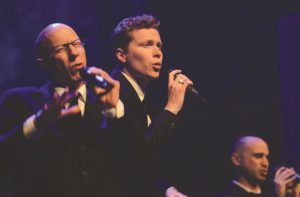
jazz as we know it
And indeed, some close harmonies, skilful imitation of instruments and rakish humour by these four charismatic Canadians were all designed to whisk us off from the Schaubühne Lindenfels into a 1940s American jazz club. Some refined interpretations of jazz classics turn out to be quite lively and they make them very much their own.
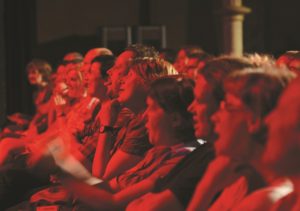
Over the years, the A Cappella Festival Leipzig has become something of a Mecca for fans of vocal music. The singers of Amarcord are kept busy, poor chaps, and are attentive to every need their guests might have, even if the feeling might arise that, rather like at a large dinner party, the otherwise excellent hosts rarely emerge from the kitchen and, when they do, hardly have time to look after themselves. One misses a central location too, where audience and performers alike can gather in the evenings, but this is a bigger city with many theatres, concert halls, churches and venues off the beaten track, and is just in the nature of things. A tendency, too, for increasing numbers of ensembles to work with microphones or actually ‘on mike’ more often than not is hardly a cause and more a symptom of a certain malaise in the genre. And a festival can hardly be responsible for this. The venue and its sound qualities play very much a determining role of course, but there is at least one well-known group that, for several decades now, has taken pride in always performing acoustic a cappella music with only extremely rare exceptions where there simply might be no other choice.

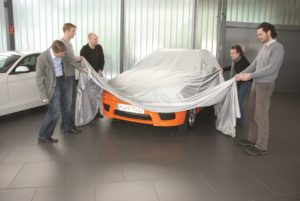
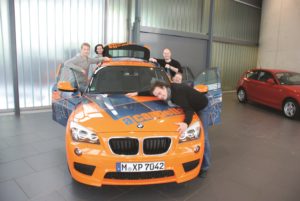
There is another vocal ensemble based in Leipzig, an excellent group, Calmus, but it seems that they have not appeared at A Cappella for almost a decade now. Strange in a way, seeing they were awarded a Special Prize for Artistic Development by the festival in 2003 and took both First Prize ‘Sacred’ and First Prize ‘Profane’ at the prestigious Tolosa Choral Contest back in 2005.
But my train was waiting. With no need to change in Naumburg this time. The once grand but now derelict Hotel Astoria grew smaller. (Is it not about time the city found an investor to renovate it, before any more gruesome post-modern cubes of glass and steel are plonked down opposite the Hauptbahnhof?) But I soon grew more content, happy just to gaze at a landscape almost devoid of colour, apart from the occasional field of yellow rape in early bloom. As we passed through Saale-Unstrut, which has the most northerly vineyard in Europe – well beyond the 51st latitude – the early spring sun made a forlorn attempt to warm the soil. The main geographical features are weathered limestone and sandstone rock, shale loam, and copper earth. The locality gets much sunshine but little rain. With only about 500 millimetres of rainfall a year, Saale-Unstrut is one of the driest wine regions of Germany. It has a very cold ‘polar winter’, and temperatures that dip to 20 degrees below zero are not uncommon. For the vines that means frost. But I had been offered sound advice at a little ‘Vinothek’ in town, and taken back a few bottles of an excellent Riesling from the ‘Weingut Schloß Proschwitz Prinz zur Lippe’. Zum Wohl!
All photos: Holger Schneider & Uwe Schürmann © DREIECK MARKETING, except Andreas Rehschuh (© HL Böhme), Gewandhaus, Werk2, Alte Handelsbörse & Peterskirche (© LTM Schmidt), Mendelssohn-Saal (© Jörg Clemen), Hainavankar (© Hainavankar) & Theaterfabrik Sachsen (© Theaterfabrik Sachsen).

